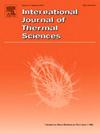Condensation and boiling in the entrance region of horizontal and inclined smooth tubes
IF 5
2区 工程技术
Q1 ENGINEERING, MECHANICAL
International Journal of Thermal Sciences
Pub Date : 2025-05-29
DOI:10.1016/j.ijthermalsci.2025.110031
引用次数: 0
Abstract
This manuscript presents the results of an experimental investigation into ammonia condensation and boiling in the entrance region of horizontal and inclined smooth tubes with an inner diameter (ID) of 11 mm. The study was conducted under saturation temperatures ranging from 55 °C to 65 °C, mass velocities between 60 and 120 kg m−2 s−1, and vapour qualities from 0.1 to 0.7. Two-phase flow pattern transitions were also examined using a transparent tube of ID 7.5 mm, equipped with ID 2 mm throttling orifice. Perturbation lengths were quantitatively evaluated for saturation temperatures between 35 °C and 55 °C, mass velocities of 80–160 kg m−2 s−1, and vapour qualities from 0.1 to 0.7. The results indicate that perturbation length is primarily determined by the initial two-phase flow pattern. The perturbation length remains unaffected by variations in saturation temperature, mass velocity, or vapour quality within the given flow pattern. In horizontal flow, the perturbation length does not exceed 23 hydraulic diameters (D) for stratified-wavy flows, and 15D for annular and annular-wavy flows. For vertical upflow, plug and churn flow regimes exhibit perturbation lengths of up to 24D, whereas annular and annular-wavy patterns remain stable beyond 20D. An L-junction does not significantly affect the flow pattern beyond a distance of 12D. In the entrance region, average condensation heat transfer coefficients (HTCs) are generally lower than those in the fully developed region at low mass velocities (<120 kg m−2 s−1) and vapour qualities (<0.7). For boiling, performance in the entrance region is comparable to that in the fully developed region at low mass velocities. However, at higher mass velocities (120 kg m−2 s−1), a slight reduction in boiling HTCs—approximately 10 %—was observed, which can be explained by the suppression of the nucleate boiling mechanism.
水平和倾斜光滑管入口区域的冷凝和沸腾
本文介绍了内径为11 mm的水平和倾斜光滑管入口区域氨冷凝和沸腾的实验研究结果。该研究在饱和温度范围为55°C至65°C,质量速度范围为60至120 kg m - 2 s - 1,蒸汽质量范围为0.1至0.7的条件下进行。两相流型转换也使用内径7.5 mm的透明管进行了测试,管内装有内径2mm的节流孔。在饱和温度为35°C至55°C,质量速度为80-160 kg m - 2 s - 1,蒸汽质量为0.1至0.7时,定量评估了扰动长度。结果表明,扰动长度主要由初始两相流型决定。在给定流型中,扰动长度不受饱和温度、质量速度或蒸汽质量变化的影响。在水平流动中,层状波流的扰动长度不超过23水力直径(D),环空和环波流的扰动长度不超过15D。对于垂直向上流动,塞流和搅拌流模式表现出高达24D的扰动长度,而环空和环波模式在20D以上保持稳定。l型结对超过12D的流型影响不显著。在低质量速度(<120 kg m−2 s−1)和蒸气质量(<0.7)下,入口区域的平均冷凝换热系数(HTCs)普遍低于完全发育区域。对于沸腾,入口区域的性能与低质量速度下完全发育区域的性能相当。然而,在较高的质量速度(120 kg m−2 s−1)下,观察到沸腾htcs的轻微减少-大约10%,这可以通过抑制核沸腾机制来解释。
本文章由计算机程序翻译,如有差异,请以英文原文为准。
求助全文
约1分钟内获得全文
求助全文
来源期刊

International Journal of Thermal Sciences
工程技术-工程:机械
CiteScore
8.10
自引率
11.10%
发文量
531
审稿时长
55 days
期刊介绍:
The International Journal of Thermal Sciences is a journal devoted to the publication of fundamental studies on the physics of transfer processes in general, with an emphasis on thermal aspects and also applied research on various processes, energy systems and the environment. Articles are published in English and French, and are subject to peer review.
The fundamental subjects considered within the scope of the journal are:
* Heat and relevant mass transfer at all scales (nano, micro and macro) and in all types of material (heterogeneous, composites, biological,...) and fluid flow
* Forced, natural or mixed convection in reactive or non-reactive media
* Single or multi–phase fluid flow with or without phase change
* Near–and far–field radiative heat transfer
* Combined modes of heat transfer in complex systems (for example, plasmas, biological, geological,...)
* Multiscale modelling
The applied research topics include:
* Heat exchangers, heat pipes, cooling processes
* Transport phenomena taking place in industrial processes (chemical, food and agricultural, metallurgical, space and aeronautical, automobile industries)
* Nano–and micro–technology for energy, space, biosystems and devices
* Heat transport analysis in advanced systems
* Impact of energy–related processes on environment, and emerging energy systems
The study of thermophysical properties of materials and fluids, thermal measurement techniques, inverse methods, and the developments of experimental methods are within the scope of the International Journal of Thermal Sciences which also covers the modelling, and numerical methods applied to thermal transfer.
 求助内容:
求助内容: 应助结果提醒方式:
应助结果提醒方式:


